Venus 60mm F/2.8 Ultra Macro Lens is the world's first 2:1 macro lens with infinity focus.
Yes, 2:1 i.e. 2X magnification. Native 2:1 magnification, all built-in - you don't have to add any accessories like extension tubes, teleconverter or Raynox diopter lens! All without losing the infinity focus too! And since you don't have to add tubes, you won't lose the ability to focus to infinity, plus, no worries about getting more dust onto the camera sensor!
This lens works on both Full Frame and APS-C camera, but on FF, expect some slight vignetting when taking non-macro shots.
When I first heard about this lens, I got really excited so I contacted the manufacturer and they were kind enough to send me a review unit.
Here's what you'll get in your package: box, warranty card, manual, UV filter (next pic), and the Venus 60mm in a nice Neoprene pouch.
You can check out other products from Venus/Laowa here.
Edit: Laowa/Venus now has a really great wide angle macro lens: Laowa 15mm 1:1 F4, and a Macro Twin Flash KX800.
Check out my "review" on the Laowa 15mm wide angle lens here.

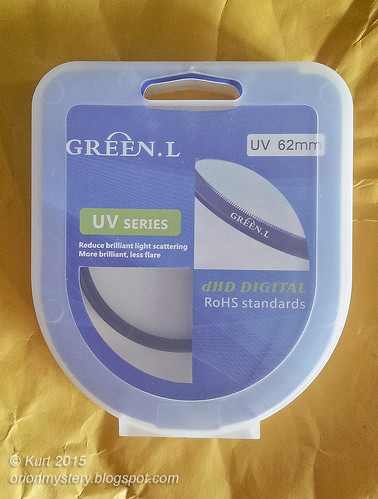
The lens is in a vacuum sealed plastic bag.
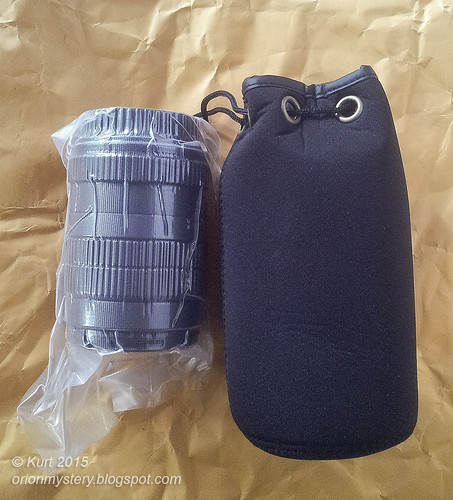
A closer look at the lens
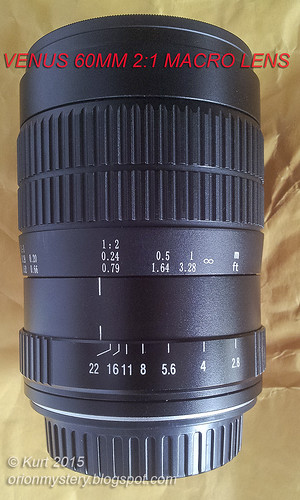
It is fully metal and feels really solid, yet not that heavy, weighing in at only 503 grams. The aperture ring is stepless and goes from F2.8 to F22.
There is no lens hood. I think it is not necessary though. The front element will be deep in the recess at infinity focus, and only comes all the way out to the front at 2X. Check out an animation here for the positions of the front elements at other magnifications.
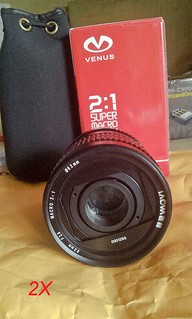


The working distances of the MP-E65 and Tamron 60mm F2 at 1:1 are about 10cm. However, I don't the shorter WD of the Venus 60mm at 1:1 to be an issue at all.


Working Distances
Working distance at 1:1 - 6 cm from front of uv filter to subject
The working distances of the MP-E65 and Tamron 60mm F2 at 1:1 are about 10cm. However, I don't the shorter WD of the Venus 60mm at 1:1 to be an issue at all.
Working distance at 2:1 - 5 cm from front of uv filter to subject
The working distance of the MP-E65 at 2:1 is 6.35cm.
For more info on the specification, optical structures & MTF, please visit Venus' website.
Full Flash, night macro

Full Res version
Full flash, night macro
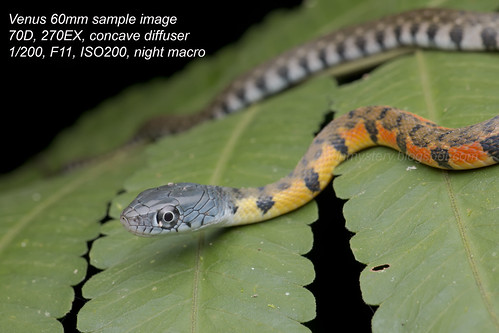
Full Res version
Full flash, night macro, 2:1
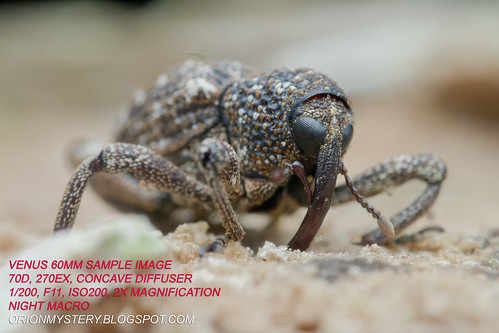
Full Res version
Full flash, night macro
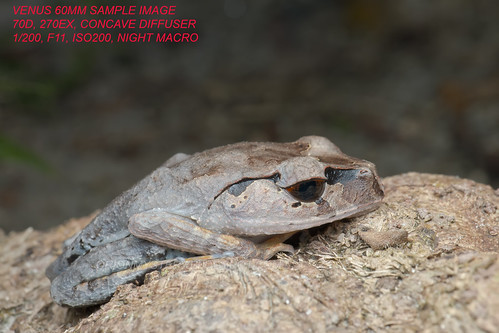
Full Res version.
Full flash, night macro
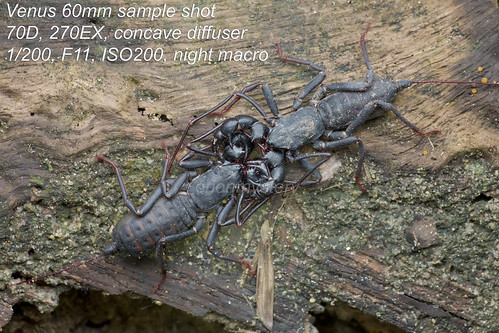
Full Res version
Venus 60mm vs Tamron 60mm vs MP-E65 at 1:1
Venus 60mm at 1:1

Links to Full Res versions: Venus 60 mm 1:1 Full Res
MP-E65 at 1:1

Link to Full Res version: MP-E65 1:1 Full Res
Tamron 60mm at 1:1

Link to Full Res version: Tamron 60mm 1:1 Full Res
Venus 60mm vs MP-E65 at 2:1
Venus 60mm at 2:1

Links to Full Res versions: Venus 60mm 2:1 Full Res
MP-E65 at 2:1

Link to Full Res: MP-E65 at 2:1 Full Res
Note: Venus 60mm's 2:1 shot seems to have shallower DOF compared to that of the MP-E65. However, I think it's because of the difference in angle. I seemed to have picked the "magic angle" in the MP-E65 shot but not in the Venus 60mm shot. I will have to redo this.
Edit: I took another Venus 2:1 shot of the same subject, but with a 40D this time.
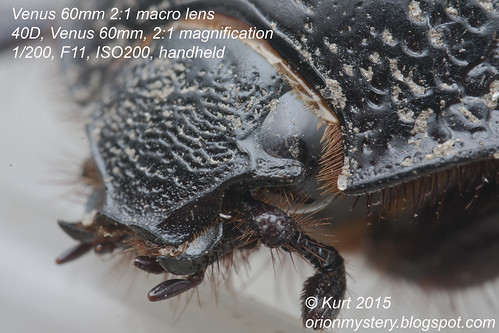
Link to Full Res: Venus 60mm at 2:1 Full Res
I think this confirms that both the Venus 60mm and MP-E65's DOFs are more or less similar at 2:1.
Full flash, day macro, daytime.
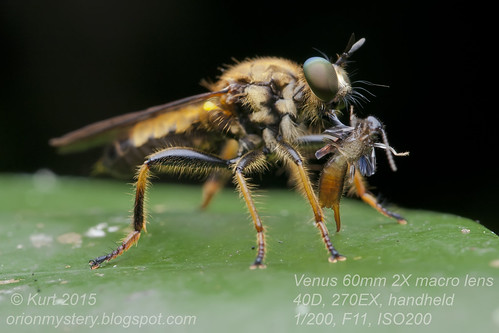
Full Res version.
Full flash, day macro, daytime.
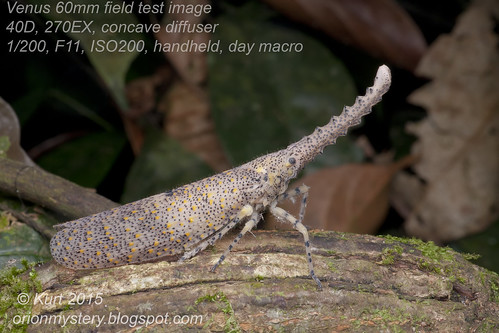
Full Res version.
Natural light, day time, handheld, daytime.
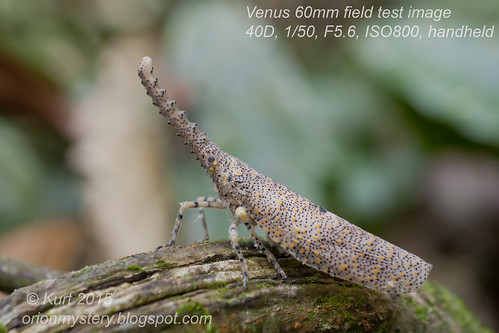
Full Res version
Natural light, tripod, live view, timer, daytime.
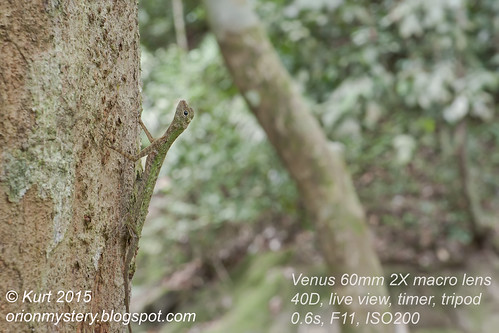
Full Res version
The bokeh from this lens is really lovely. Also note mentioning is that when shooting with natural light on a tripod, the use of live view makes the dark view finder a non-issue.
Natural light, tripod, live view, timer, daytime.
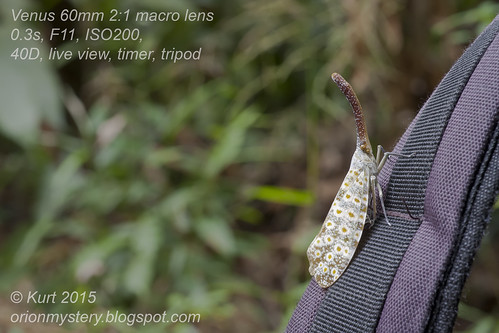
Full Res version
Natural light, tripod, live view, timer, daytime
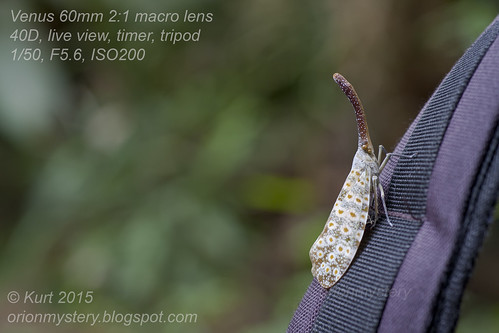
Full Res version
Full flash, day macro, 2:1, daytime
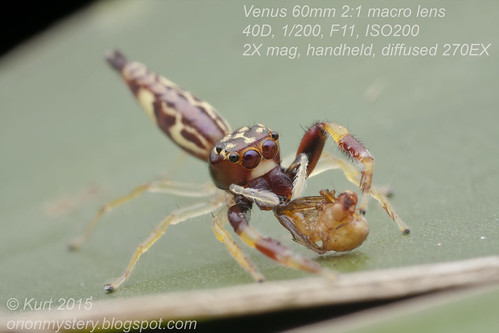
Full Res version
Full flash, daytime
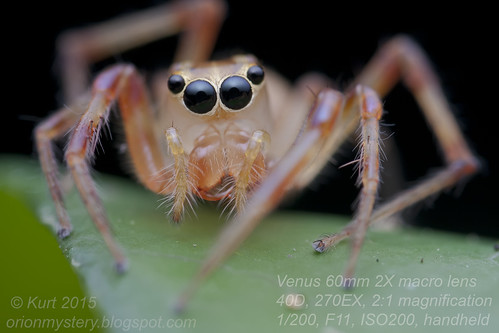
Full Res version
Natural light, live view, timer, tripod, daytime.

Full Res version
Full flash, daytime.
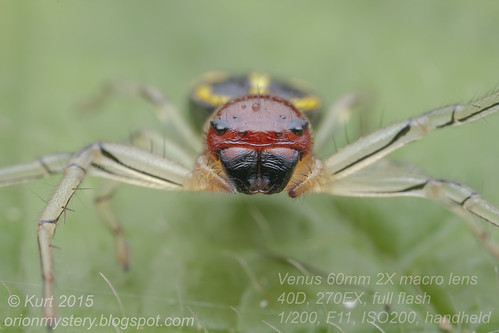
Full Res version
Note: more field test images will be added.
You can also view more Full Res raw images on Venus' website:
I have using a Sigma 150mm, Tamron 60mm and the MP-E65 for a long time and I can tell you that the IQ of this Venus 60mm is on par with all of those. Check out the full res images above and let me know if you think otherwise.
With macro lenses like the Tamron 60mm, Canon 100mm IS, and MP-E65, even after you set the aperture (via the camera body) to F11, the lens still stays wide open at F2.8 (F2.0 for the Tamron 60mm), until the moment you fully press the shutter button. That is when the lens will stop down to F11. The lens will go back to being wide open right after the exposure.
With the Venus 60mm, there is no communication between the lens and the camera. If you normally use F11 for macro, you'll have to dial the lens' aperture ring to F11. The lens will stop down immediately and what you see via the viewfinder will be very dim. You will need good focusing light to overcome this issue. This is true for full flash macro photography with typical setting of 1/200, F11, ISO100/200.
If you have never used a manual macro lens with no auto stopdown / auto aperture, you can still find out what it is like to focus with the lens stopped down to say F11. Just set your camera to F11, then "press and hold" the Depth of Field Preview button to stop down the lens.
Focusing on the Venus 60mm with the lens stopped down to F11 is not easy. The viewfinder becomes very dark. I use a Fenix E11/E12 flashlight/torchlight as my focusing light, day and night. It is good enough for wide open lenses like the Tamron 60mm F2, MP-E65 or Canon 100mm L, but totally inadequate for the Venus 60mm. At times, I have to use my bigger flashlight/torchlight, a Fenix E25 to help me focus better.
Here's what my E11 focusing light looks like. The focusing light (Fenix E11) is clipped onto the bounce card.
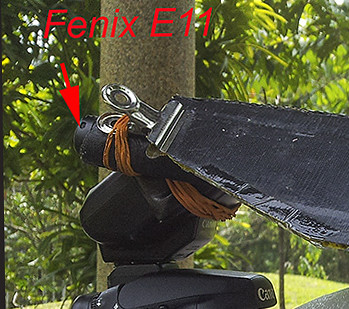
Some very crude DIY there, I know, but it works.

You can also use a compact but powerful headlamp as your focusing light. Use bands or velcro to fasten it to your speedlite.
Edit: I now clip the Fenix E11 onto the diffuser rather than on the bounce like before. This definitely makes focusing so much easier than before! More field tests needed to see if there is any side effects.
Shooting with natural light with this lens on a tripod is a breeze. The dark viewfinder is no longer an issue as you can use the live view function but make sure you turn exposure simulation on. You can then zoom in to 5X or 10X to fine tune your focus.
On the plus side, it's really sweet to be able to go from infinity focus one minute, and then 1X or even 2X the next. Native 2:1 magnification, all built-in - you don't have to add any accessories like extension tubes, teleconverter or Raynox diopter lens! All without losing the infinity focus too! And since you don't have to add tubes, you won't lose the ability to focus to infinity, plus, no worries about getting more dust onto the camera sensor!
- Thomas Shahan's video review of Venus 60mm 2:1 macro lens.
- Robchaos' review
If you are interested in this lens, you can purchase it directly from Venus' website for US$379 including shipping. There will be a further US$10 discount from now until Feb 28, 2015. Venus 60mm 2:1 macro lens is available in the following mounts:
- Nikon F
- Canon EF
- Sony A
- Pentax K
- Micro Four Third (with adaptor) - add US$20
- Sony NEX (with adaptor) - add US$20
- Fuji X (with adaptor) - add US$20
Macro lenses and flashlight from Laowa/Venus:
Venus 60mm F2 2:1 macro lens.
Laowa 15mm F4 1:1 wide angle macro lens
Macro Twin Flash KX800
Buy your Laowa / Venus lenses and accessories here.
As an Amazon Associate I earn from qualifying purchases.

The working distance of the MP-E65 at 2:1 is 6.35cm.
For more info on the specification, optical structures & MTF, please visit Venus' website.
Field Test Images
Round 1:
All images were taken at night with a 70D, diffused 270EX, handheld, with a Fenix E11 flashlight/torchlight (and at times, a Fenix E25 flashlight/torchlight as well) for focusing.Full Flash, night macro

Full Res version
Full flash, night macro

Full Res version
Full flash, night macro, 2:1

Full Res version
Full flash, night macro

Full Res version.
Full flash, night macro

Full Res version
Venus 60mm vs Tamron 60mm vs MP-E65 at 1:1

Links to Full Res versions: Venus 60 mm 1:1 Full Res
MP-E65 at 1:1

Link to Full Res version: MP-E65 1:1 Full Res
Tamron 60mm at 1:1

Link to Full Res version: Tamron 60mm 1:1 Full Res
Venus 60mm vs MP-E65 at 2:1
Venus 60mm at 2:1

Links to Full Res versions: Venus 60mm 2:1 Full Res
MP-E65 at 2:1

Link to Full Res: MP-E65 at 2:1 Full Res
Note: Venus 60mm's 2:1 shot seems to have shallower DOF compared to that of the MP-E65. However, I think it's because of the difference in angle. I seemed to have picked the "magic angle" in the MP-E65 shot but not in the Venus 60mm shot. I will have to redo this.
Edit: I took another Venus 2:1 shot of the same subject, but with a 40D this time.

Link to Full Res: Venus 60mm at 2:1 Full Res
I think this confirms that both the Venus 60mm and MP-E65's DOFs are more or less similar at 2:1.
Round 2
All images were taken during daytime with a 40D, diffused 270EX, handheld, with a Fenix E11 flashlight/torchlight for focusing when in full flash macro mode; and tripod plus timer for natural light shots.Full flash, day macro, daytime.

Full Res version.
Full flash, day macro, daytime.

Full Res version.
Natural light, day time, handheld, daytime.

Full Res version
Natural light, tripod, live view, timer, daytime.

Full Res version
The bokeh from this lens is really lovely. Also note mentioning is that when shooting with natural light on a tripod, the use of live view makes the dark view finder a non-issue.
Natural light, tripod, live view, timer, daytime.

Full Res version
Natural light, tripod, live view, timer, daytime

Full Res version
Full flash, day macro, 2:1, daytime

Full Res version
Full flash, daytime

Full Res version
Natural light, live view, timer, tripod, daytime.

Full Res version
Full flash, daytime.

Full Res version
Note: more field test images will be added.
You can also view more Full Res raw images on Venus' website:
Image Quality
I have using a Sigma 150mm, Tamron 60mm and the MP-E65 for a long time and I can tell you that the IQ of this Venus 60mm is on par with all of those. Check out the full res images above and let me know if you think otherwise.
Handling
This is a fully manual lens with no auto aperture / auto stop-down.With macro lenses like the Tamron 60mm, Canon 100mm IS, and MP-E65, even after you set the aperture (via the camera body) to F11, the lens still stays wide open at F2.8 (F2.0 for the Tamron 60mm), until the moment you fully press the shutter button. That is when the lens will stop down to F11. The lens will go back to being wide open right after the exposure.
With the Venus 60mm, there is no communication between the lens and the camera. If you normally use F11 for macro, you'll have to dial the lens' aperture ring to F11. The lens will stop down immediately and what you see via the viewfinder will be very dim. You will need good focusing light to overcome this issue. This is true for full flash macro photography with typical setting of 1/200, F11, ISO100/200.
If you have never used a manual macro lens with no auto stopdown / auto aperture, you can still find out what it is like to focus with the lens stopped down to say F11. Just set your camera to F11, then "press and hold" the Depth of Field Preview button to stop down the lens.
Focusing on the Venus 60mm with the lens stopped down to F11 is not easy. The viewfinder becomes very dark. I use a Fenix E11/E12 flashlight/torchlight as my focusing light, day and night. It is good enough for wide open lenses like the Tamron 60mm F2, MP-E65 or Canon 100mm L, but totally inadequate for the Venus 60mm. At times, I have to use my bigger flashlight/torchlight, a Fenix E25 to help me focus better.
Here's what my E11 focusing light looks like. The focusing light (Fenix E11) is clipped onto the bounce card.

Some very crude DIY there, I know, but it works.

You can also use a compact but powerful headlamp as your focusing light. Use bands or velcro to fasten it to your speedlite.
Edit: I now clip the Fenix E11 onto the diffuser rather than on the bounce like before. This definitely makes focusing so much easier than before! More field tests needed to see if there is any side effects.
Shooting with natural light with this lens on a tripod is a breeze. The dark viewfinder is no longer an issue as you can use the live view function but make sure you turn exposure simulation on. You can then zoom in to 5X or 10X to fine tune your focus.
On the plus side, it's really sweet to be able to go from infinity focus one minute, and then 1X or even 2X the next. Native 2:1 magnification, all built-in - you don't have to add any accessories like extension tubes, teleconverter or Raynox diopter lens! All without losing the infinity focus too! And since you don't have to add tubes, you won't lose the ability to focus to infinity, plus, no worries about getting more dust onto the camera sensor!
Other reviews:
- Thomas Shahan's video review of Venus 60mm 2:1 macro lens.
- Robchaos' review
Price and Mounts Available
If you are interested in this lens, you can purchase it directly from Venus' website for US$379 including shipping. There will be a further US$10 discount from now until Feb 28, 2015. Venus 60mm 2:1 macro lens is available in the following mounts:
- Nikon F
- Canon EF
- Sony A
- Pentax K
- Micro Four Third (with adaptor) - add US$20
- Sony NEX (with adaptor) - add US$20
- Fuji X (with adaptor) - add US$20
Macro lenses and flashlight from Laowa/Venus:
Venus 60mm F2 2:1 macro lens.
Laowa 15mm F4 1:1 wide angle macro lens
Macro Twin Flash KX800
Buy your Laowa / Venus lenses and accessories here.
As an Amazon Associate I earn from qualifying purchases.